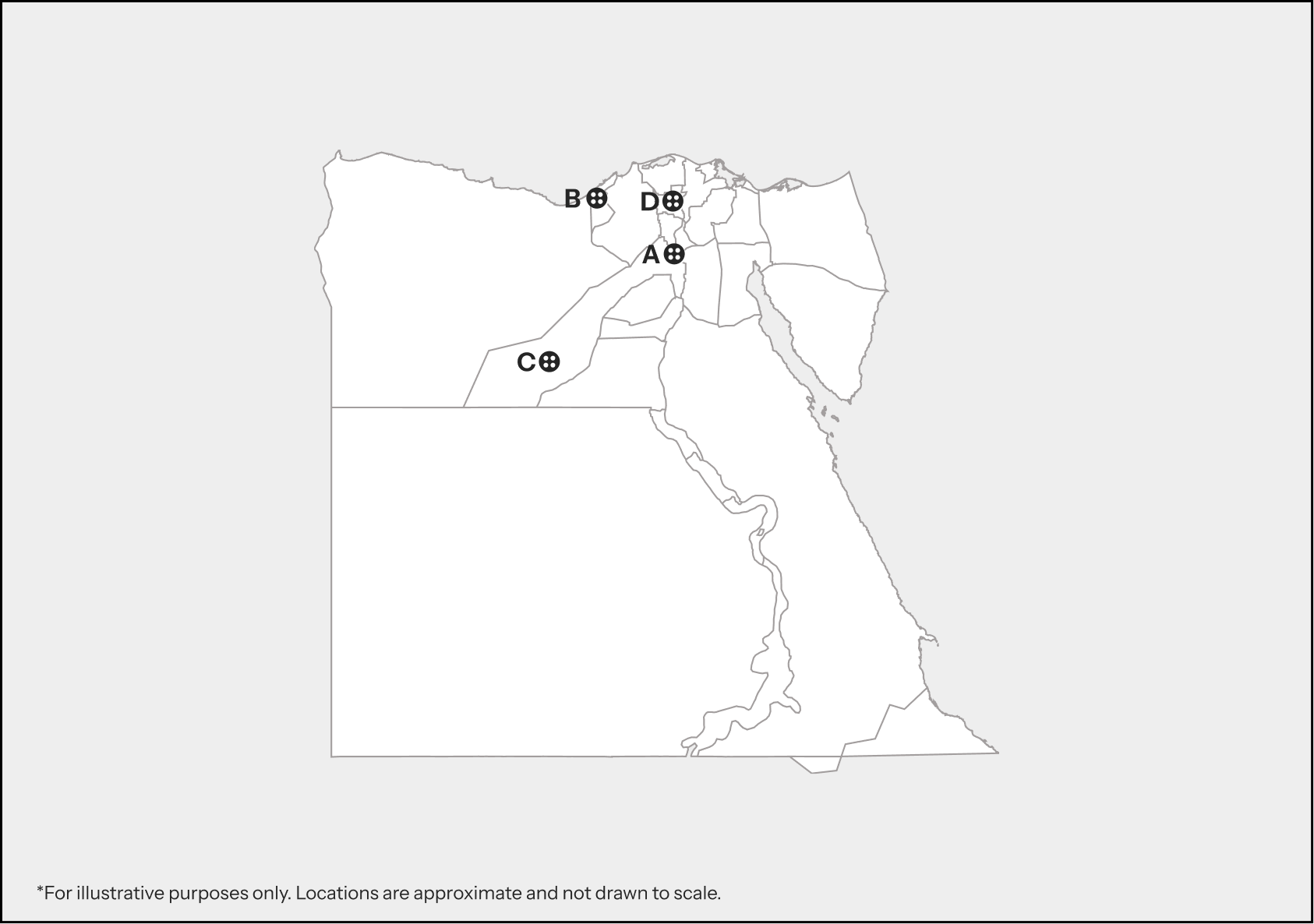Egypt
download summary
Country Overview
No items found.
*All data is in tonnes per annum
TEXTILE WASTE*
212,000
Post consumer textile waste
=
100% cotton
Cotton- rich blends
Poly- rich blends
100% Polyester
Other synthetics
Other natural fibres
Other manmade cellulosic fibres
Other Blends
pre consumer textile waste
Post Industrial textile waste
212,000
100% cotton
37.00%
Cotton- rich blends
13.00%
Poly- rich blends
10.00%
100% Polyester
11.00%
Other synthetics
4.00%
Other natural fibres
6.00%
Other manmade cellulosic fibres
3.00%
Other Blends
9.00%
Imported textile waste
100% cotton
Cotton- rich blends
Poly- rich blends
100% Polyester
Other synthetics
Other natural fibres
Other manmade cellulosic fibres
Other Blends
*This data is from UNIDO switchmed North Africa
KEY POINTS ON Textiles & Apparels LANDSCAPE
$ 2.846B
Apparel Export
As Egypt’s second-largest industrial sector, textiles and apparel account for 8% of exports, 34% of industrial production, and 3.4% of GDP. The country exports mainly woven goods to the USA, Turkey, and Saudi Arabia, benefiting from duty-free access to the EU with a double transformation rule of origin.
$475M
Cotton Exports (2024)
$868M
Cotton Imports (2024)
Egypt is Africa’s leading producer of extra-long-staple (Giza) cotton, cultivating 300–400 thousand bales annually, with around 80% grown in the Nile Delta. While it produces the world’s highest-quality cotton, domestic demand significantly exceeds supply, making the country a net importer. Most of Egypt’s textile industry relies on imported short- and medium-staple cotton varieties, commonly used in products such as denim and T-shirts. The sector also depends heavily on man made fiber imports, given limited local production. In contrast, Egyptian ELS cotton is used for premium home textiles and high-end apparel
90%
Egypt’s apparel production is handled by private industries
Egypt’s textile industry covers all tiers of the supply chain, with the public sector leading in spinning, weaving, and hemming, while most garment production is privately managed. The country remains highly competitive in spinning and weaving thanks to its strategic location, low labor costs, and affordable electricity. It hosts around 3,243 companies, producing 315 million apparel items, with 25% of the industry focused on textile production.
35%
high-value waste is recycled to average standards
55%
high-value waste is recycled to best international standards
As per the UNIDO report, Egypt’s waste market is more structured, active, and profitable than Tunisia or Morocco. While some T2T recycling exists, it often relies on spinning waste or imported feedstock due to local quality issues. High-quality waste (100% cotton or cotton-rich) is mostly exported or downcycled into automotive, mattress, or pillow industries.
waste cost
waste Type
composition
price
notes
No data available
- RMG waste represents the biggest volume of Egypt textile waste
- The RMG waste in the Egyptian industry is expected to be a lower-quality cotton waste as 70% of its cotton is exported out and the remaining is used for home-textile industry
production clusters
Key regions with fibre production
Beheira(A), Kafr El-Sheikh(B), Monufia(C), Damietta (D), Beni Suef (E), Sohag (F)

Key regions with apparel production
Cairo(A), Alexandria(B), Giza(C), and El-Gharbeya(D)

- Egypt is attracting significant investment in its textile industry through the development of specialized industrial zones, most notably Al Sadat City. These zones provide “plug-and-play” infrastructure, allowing companies to set up quickly and operate efficiently while reducing long-term overhead costs.
Waste regulation
It aims to transform Egypt’s waste sector by establishing climate-sensitive, circular economy-based solid waste management systems. It supports institutional development, policy implementation, infrastructure upgrades, and capacity building in targeted governorates (Kafr El Sheikh, Qena, Gharbia, and Asyut). The program also enables green private sector investments while reducing environmental and public health risks associated with poor waste management.
Waste trade
15.27 kT
Import quantities (HS 6309, 631010)
0.12 kT
Export quantities (HS 6309, 631010)
- Greater Cairo region represents more than 50% of the country’s yearly waste generation
- In Free Zones, textile and garment waste management is hindered as all waste must be cleared by customs before leaving the zone. This adds administrative and bureaucratic layers, slowing down efficient handling.
green energy
3.03%
Share of modern renewables in final energy consumption
- Egypt’s Investment Law No. 72/2017: It provides tax deductions, customs exemptions, and streamlined approvals to encourage investments in renewable energy, benefiting green energy projects and industries like textile manufacturing integrating sustainable energy solutions. This boosts financial viability and operational ease for both local and foreign investors
- GEFF Egypt, managed by the EBRD: It provides concessional loans and technical support via local banks to promote renewable energy and energy-efficient technologies. It specifically targets MSMEs, helping them overcome financial barriers to green investment. By enabling sustainable upgrades, the program enhances MSME competitiveness while advancing Egypt’s green economy goals.

